The Big Picture Pillars
Eleven talented local artists are coming together to create a vibrant and aesthetic precinct, as part of the Flinders Link Project.
The BIG Picture Pillars lead by Joel ‘VTO’ Moore (Creative Director) and Rail Care (DIT) have brought together 11 diverse and experienced large scale mural artists from South Australia for this ambitious project.
Located in the Laffer’s Triangle area, eleven murals side-by-side have been painted on the newly built concrete pillars and 2 Abutment walls, covering 500 square metres of infrastructure.
The artists were asked to consider the diverse amount of local activity in the area such as Flinders and Tonsley precincts including the 2 local council areas the infrastructure straddles when considering
their designs.
The theme ‘Looking to the Future’ highlights the innovative research, technology advanced manufacturing undertaken at Flinders and Tonsley precincts, but there is also Kaurna-inspired and inspired artworks and references to the local environment.
From the 16th November – 4th December the artists have been painting on site creating 11 incredible artworks for the public to enjoy and hopefully be inspired by.
The Pillars
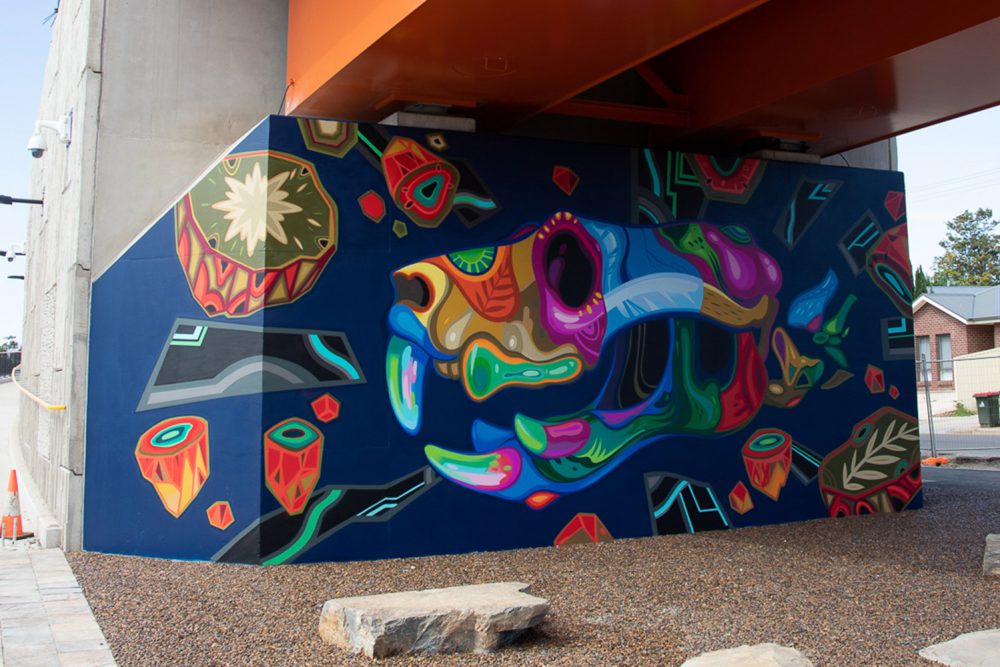
Abutment A
Sarah Boese
This design represents the idea of how all fossils each tell a unique story. The study of prehistoric climates is present in the collage of colours that make up the skull; depicting a variety of environments ranging from desert wastelands, tropical forests, volcanic activity and the Ice Age landscape.
The skull belongs to a Marsupial Lion called a Thylacoleo and is depicted as having Opalised sections of bone and teeth to tie it back to the world-class palaeontology research at Flinders. The opal aesthetic also emphasises the value of fossils and suggests the immense scale of time that they reveal.
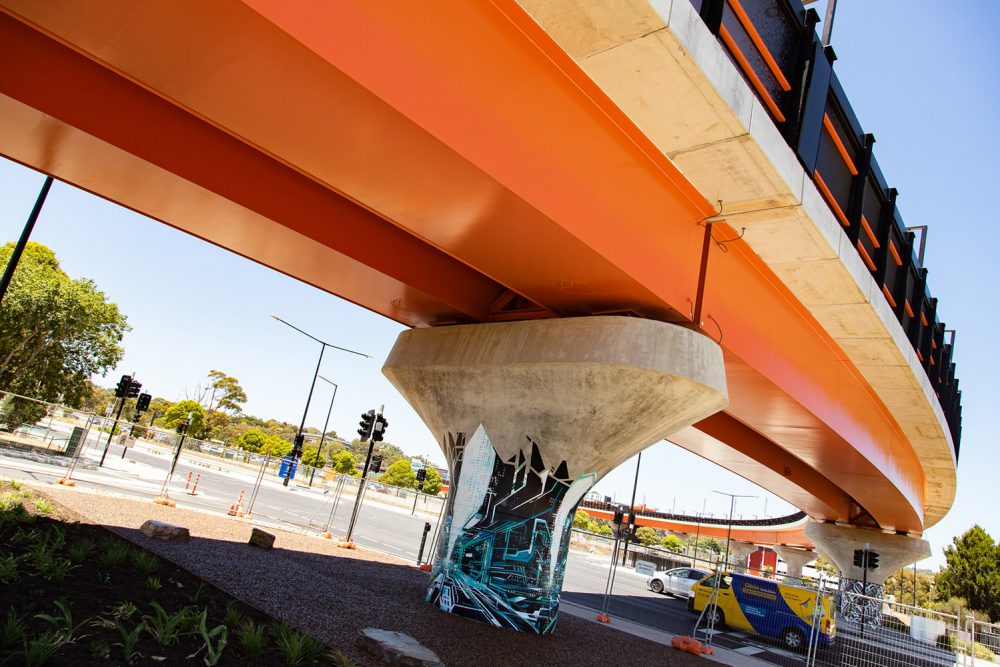
Pillar 1
Thom Buchanan
Our senses in the computer age travel at hyper speeds through search engines and electrical circuitry, along a data web of information that has changed the way we live and communicate. This work captures these cyber-synergies and glimpses future landscapes and technologies, a 3-dimensional cartography that maps the illusionary and imagined spaces we all inhabit in one way or another. Mirrored virtual environs create a pathway through solid matter, cloning the ether that sculpts the subliminal undercurrent of data streams, solidifying what can’t be literally grasped.
The overlay of binary numbers is a code for cryptography, the very language that allows computers to function. My interpretations of these hieroglyphs are the universal human elements of safety, security, health, language and home, common threads used as building blocks that have constructed great civilizations and societies, propelling us beyond an exciting new frontier.
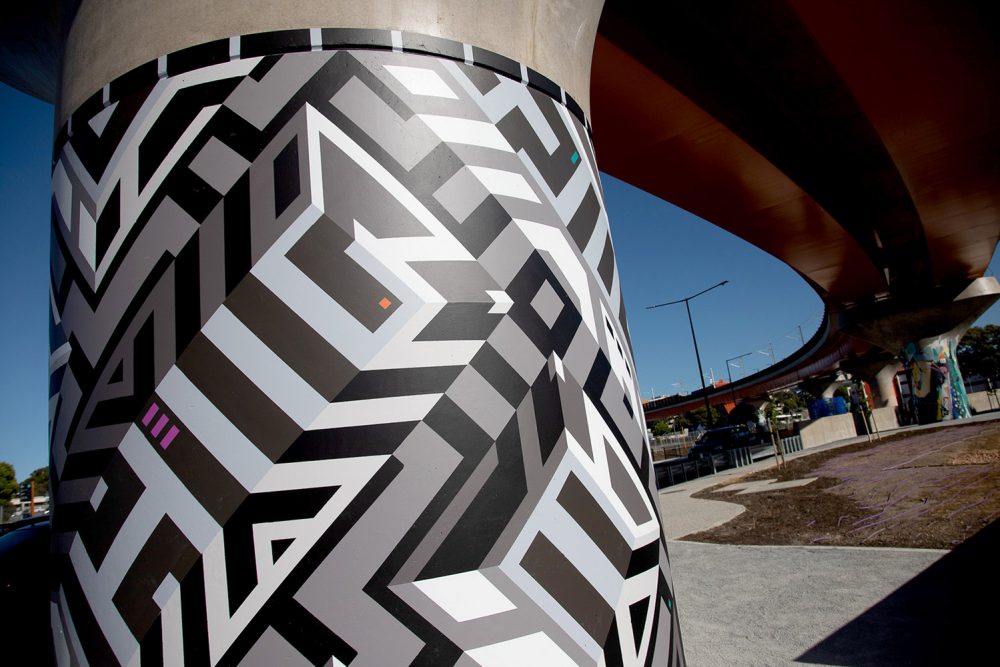
Pillar 2
Sam Songailo
The concept I have developed is reflective of the various ways in which different technologies are deployed and interwoven to generate new outcomes. Thinking around disciplines is being transformed as they merge with others once thought disparate to create new ways of working.
My work is a visualisation of this new dynamic and represents this new interlaced network of technologies. Unexpected pathways emerge to open up possibilities that were previously unthought-of, revealing a mesh of parts that seamlessly moves from the physical to the virtual and back again.
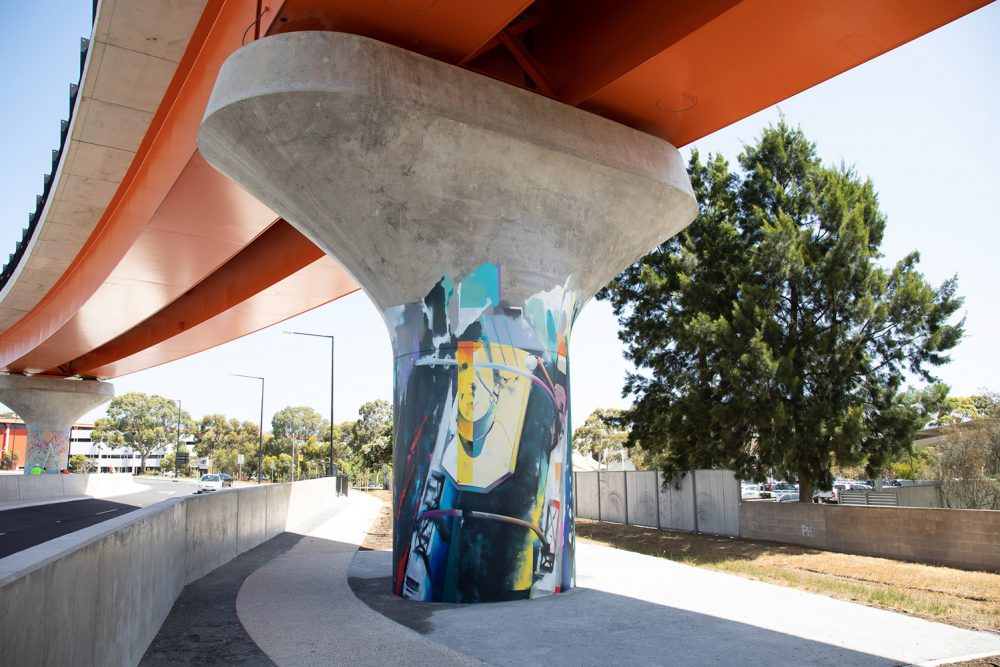
Pillar 3
Tarns One
This artwork has referenced ‘TOPCAT’ one of the autonomous marine vehicles being engineered by Professor Karl Sammut and students of Flinders University.
It also features elements of a radar read out from their apparatus, slightly subliminal and abstracted to suit my style. Water and air are represented as is movement which represents transportation and (metaphorically) our constant journey into the future.
I feel that my design and Dave’s already had similar elements and use of colour, I have implemented some grey scale shapes to tie in with Sam’s design and I feel that there will be apparent synergy and harmony throughout.
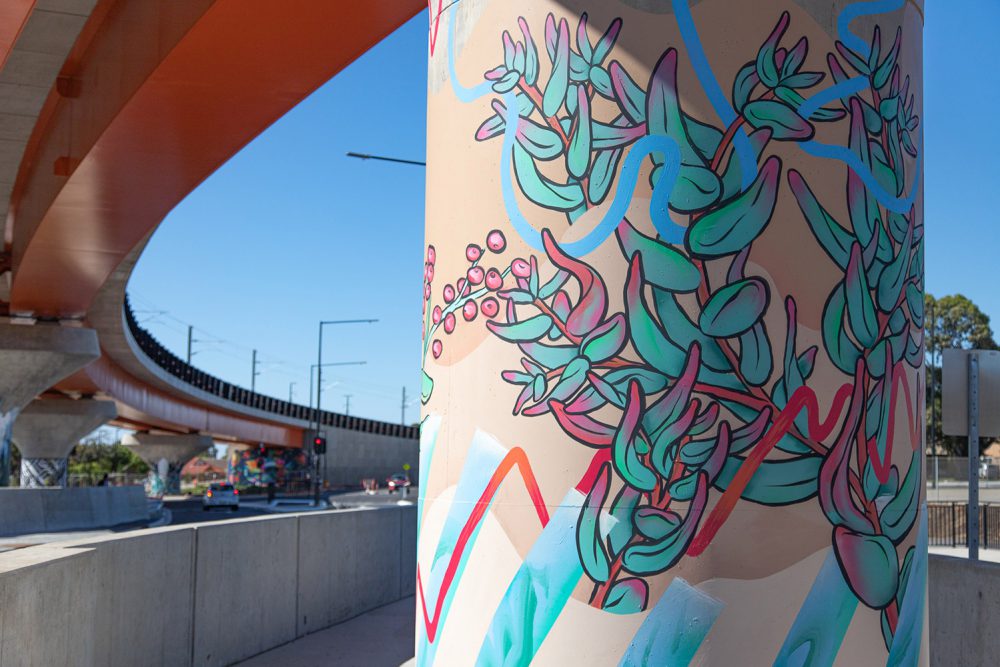
Pillar 4
Dave Court
Wind, Waves, Sand and Heat
This painting is based around the coastal marine environment, and changes to dune structure and vegetation due to climate change, loosely referencing the work of Flinders University academic Professor Patrick Hesp who has been publishing research on the subject since 1975.
It contains semi-abstracted representations of four elements that dictate the past, present and future of the coastal marine environment, which are wrapped around illustrations of native coastal plant species.
- Wind – Sea winds and salt spray that impact dune formation and vegetation growth.
- Earth – Sand, dunes, habitat for coastal flora and fauna.
- Water – Ocean salinity, sea level, temperature, tidal and wave activity.
- Fire – Increasing temperatures, climate change, increasing ecological instability.
Increase in global temperature anomaly from 1975 to 2020, representative of how much climate and the environment can change over the course of a single person’s career and observation.
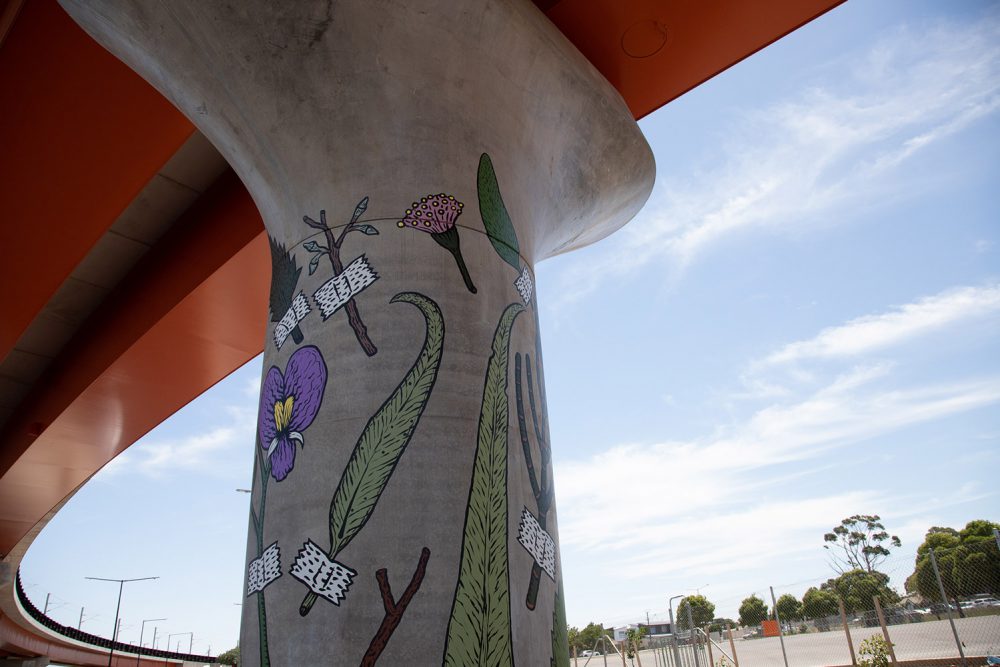
Pillar 5
Billie Justice Thompson
These collected native leaves and flowers seemingly taped to the pillar are a way of capturing the idea that we must observe, respect and listen to our natural environment. It also represents preserved herbarium foliage samples taking inspiration from the Adelaide born botanical artist Rosa Fiveash (b1854 d1938). Conservation of living plants, with reference to the Mitcham Hills is also referenced.
The colour, shape and condition of leaves can tell us how the ecosystem is functioning. Trees use small apertures in leaves called stomata in a way very much like how we use a valve to control water flow in a pipe.
Climate change is impacting our native flora and I’ve chosen to really focus on foliage as opposed to flowers because they’re often over looked but offer so much both visually and environmentally.
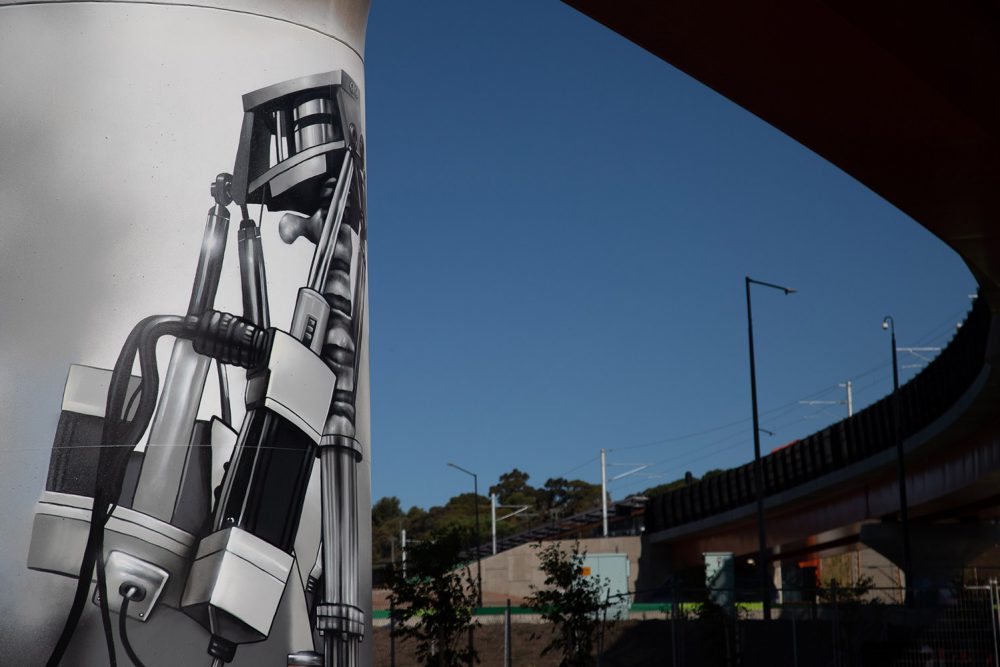
Pillar 6
Thomas Readett
The subject of my mural is the Hexapod Robot. This incredible piece of world leading technology was created here in Adelaide at Tonsley/Flinders by Dr John Costi and his team. The robot was designed to help researchers further understand the limits and restrictions of human skeletal joints, the main area of research being the 5 Lumber Vertebrae of the spine.
Using this robot to mimic human movements over time allows the team to create prosthetics and bone replacements for people living with musculoskeletal issues. This robot and the team that created it have helped thousands of Australians and I think both the Hexapod and the engineers that made it deserve to be honoured by this piece.
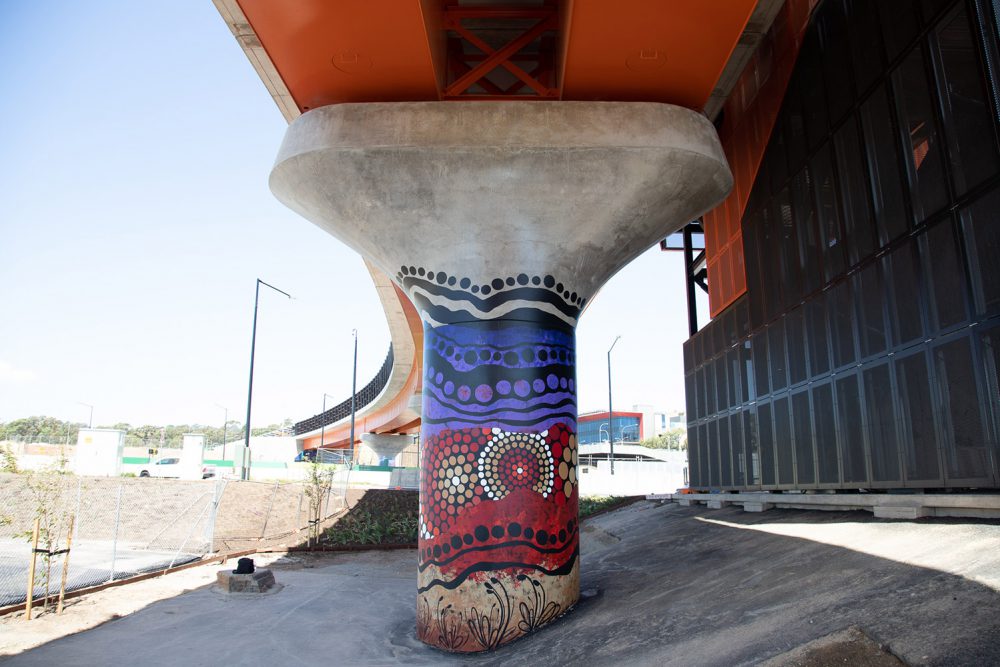
Pillar 7
Elizabeth Close
This concept is underpinned by Kaurna Women; their strength and their resilience. It acknowledges the place that Aboriginal and Torres Strait Islander women have in preserving culture, and specifically, the role of Kaurna women.
The landscape shapes speak to the connection that Kaurna have to Mt Lofty, and the place it has in Kaurna song lines, stories and Moitey Groups. At the base of this, are the bulrushes which speak to Kaurna women’s use of the bulrush for weaving to create baskets and piti, it is the very foundation for the artwork just as Kaurna women are at the very Foundation for Kaurna broadly, but also for the Adelaide Aboriginal Community.
The section with coloured red and earth toned dots represents Aboriginal and Torres Strait Islander people from other Language Groups living on Kaurna Country, and acknowledges the manner in which we have been made to feel welcome and valued by the Kaurna Community. This is an attitude that has been instilled by such past community leaders such as beloved Uncle Stevie Goldsmith, Aunty Josie and Aunty Alice, whose passing was met with profound sadness from all corners of the community.
These past leaders are represented by the ‘negative space’ dots in the black section at the top – here and never forgotten, but with the ancestors. Finally, the black dots represent Kaurna themselves. The palette is reminiscent of the palette and texture created in the Pedestrian Culvert, which was underpinned by a connection to Country represented by the earth tones, and storytelling represented by the red and purple reflections of the place that fire and smoke plays in the sharing of culture.
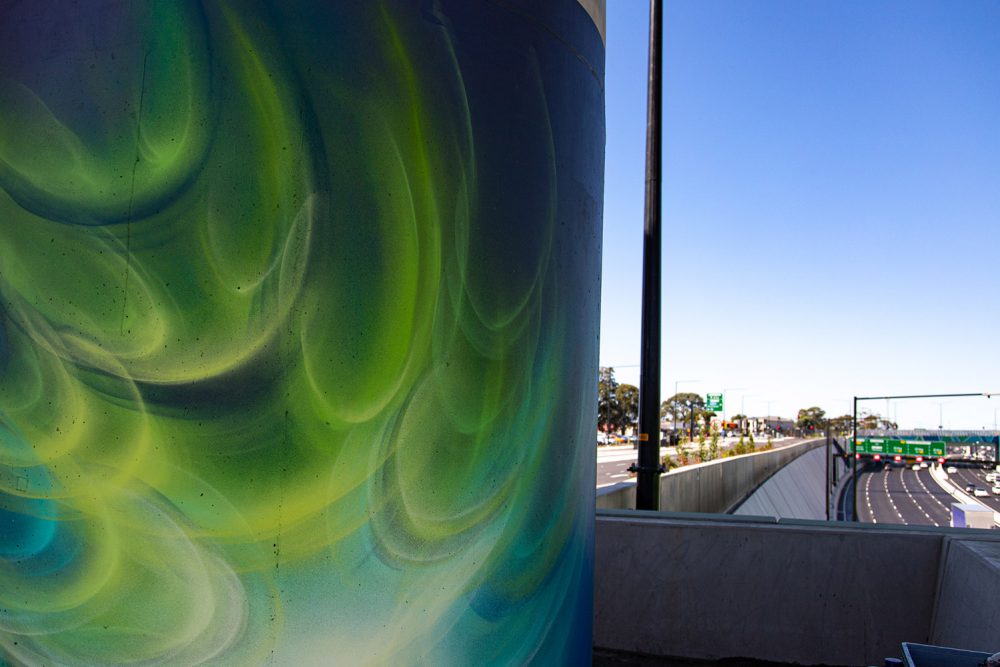
Pillar 8
Order 55
The painting speaks to the underlying interrelationships within the natural world. In this colour palette the sense of water and the living world interact in unison, one effecting the other, always in balance, always having an abundance of energy. Learning from nature’s systems, observing and then replicating the many complexities is the core of sustainability.
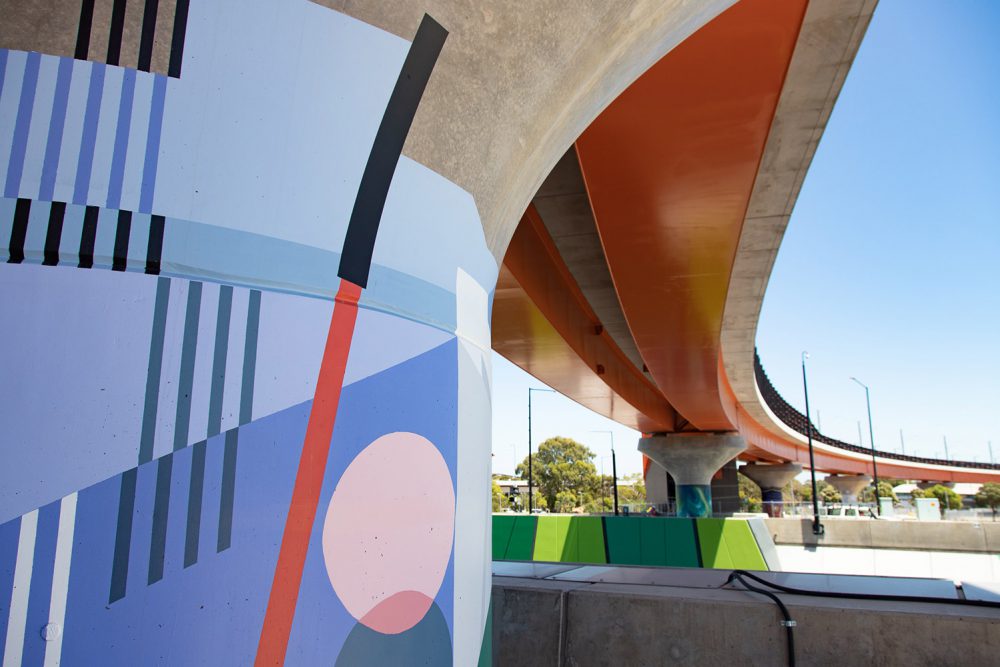
Pillar 9
Fortrose
My design is an abstract interpretation of an additive manufacturing process called powder bed fusion, a process where an energy source, such as a laser or electron beam is used to fuse particulate materials such as metals, ceramic or polymers to form a three-dimensional object.
Important characteristics in the process of powder bed fusion such as particle size, particle shape, elemental composition and microstructure are all key in optimizing the outcome, similar to an abstract painting, it’s these same characteristics that were followed in the creation of the painting.
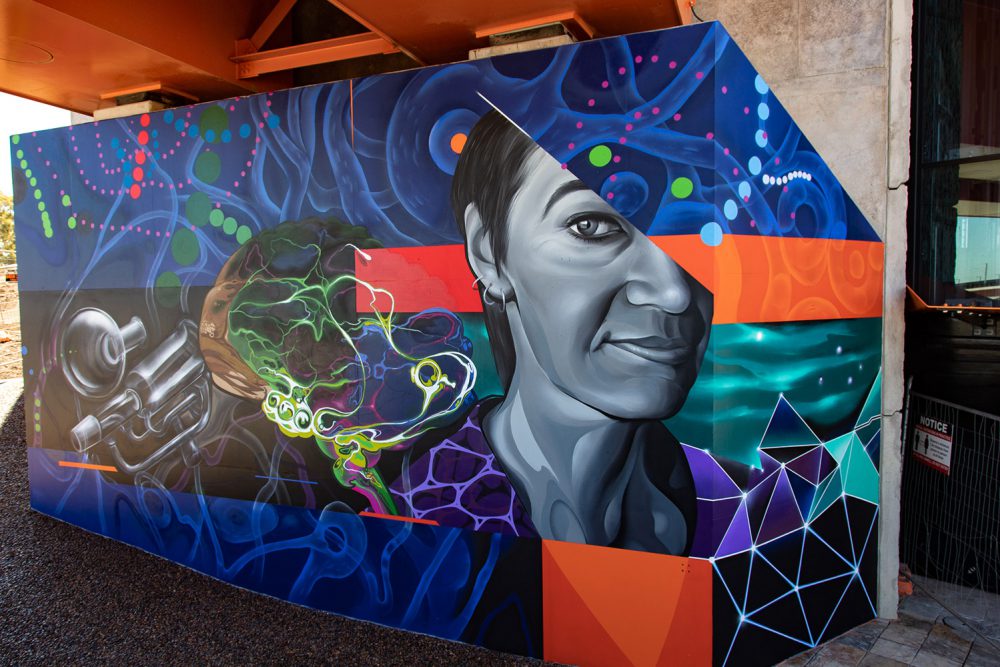
Abutment B
Vans the Omega
This artwork titled- “Becoming” is a creative dissection, which looks at Neuro science head Karin Nordstrom and her teams research and 3D mapping of the Hover Fly at Flinders Medical. along with the brains mental capacity and imagination used to set up experiments, testing and the equipment needed to form scientific breakthroughs. Featured elements comprise of Neural pathways, geometry and data from lab experiments. It captures how a brain diagnosis maps the fractal jigsaw puzzle of dexterity, the capacity of abstract thought and highly complex functions…
In Collaboration with Department for Infrastructure and Transport




